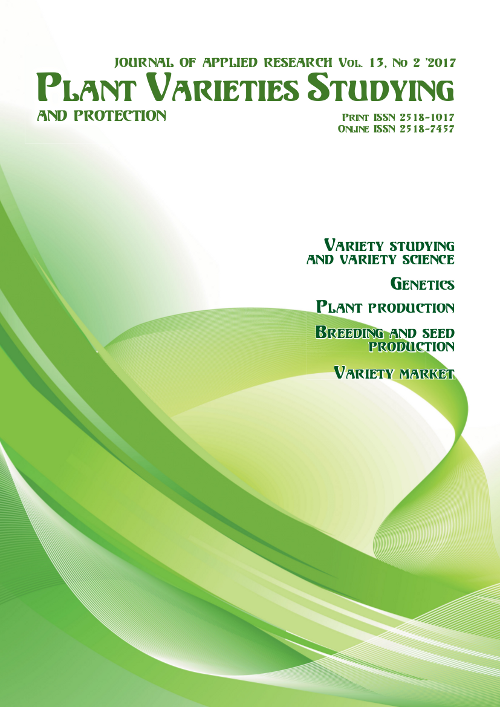Estimation of lavender (<i>Lavandula angustifolia</i>) frost resistance
DOI:
https://doi.org/10.21498/2518-1017.13.2.2017.105397Keywords:
plants, temperature, spreading, frost resistance, Forest-Steppe zone of UkraineAbstract
Purpose. To study effects of low temperatures on Lavandula angustifolia plants and their response depending on their age and variety as well as identify critical temperature values for such structure elements of plants as bark, cambium, wood, pith.
Methods. Field investigation, spectrometric analysis, statistical evaluation.
Results. Topicality of investigation of Lavandula angustifolia to be grown in the Forest-Steppe zone of Ukraine was highlighted. Low temperature effects on structural elements of shoots for 8 varieties of domestic and foreign selection were analyzed. One-year shoots have suffered the most from low temperatures – 4.5 points on a six-point scale, two- and three-year shoots were damaged in a lesser degree – from 0.8 to 2 points. Plants of ‘Feuervogel’ and ‘Maestro’ varieties with total damage coefficient of 11.3% and 10.6% accordingly were the most resistant to low temperatures. These varieties can be recommended to producers for further introduction to the Forest-Steppe zone of Ukraine.
Conclusions. Tissues of a lavender one-year shoot were most damaged by low temperatures regardless of a variety, but this organ is ephemeral and can be removed without causing damage to a plant. Two- and three-year shoots, which provide plant recovery, were significantly less damaged. None of the plants from 8 studied lavender varieties was lost under the influence of low temperatures, though some of them were damaged significantly. Such varieties as ‘Feuervogel’, ‘König Humbert’, ‘Veseli notky’ (pith damage is on the level of 1–2 points), ‘Maestro’ (0.8–2.5 points) were the most resistant to low temperature exposure which allows to conclude about successful lavender cultivation under conditions of the Forest-Steppe zone of Ukraine.
Downloads
References
Cavanagh, H. M. A., & Wilkinson, J. M. (2002). Biological activities of Lavender essential oil. Phytother Res., 16(4), 301–308. doi: 10.1002/ptr.1103
Yezhov, V. M., Rudnyk-Ivashchenko, O. I., & Shevel, L. O. (2014). Ornamental plant production in Ukraine: prospects of structuring and sustainable development. Visnyk ahrarnoi nauky [Вulletin of Agricultural Science], 12, 10–15. [in Ukrainian]
Yezhov, V. M., Rudnyk-Ivashchenko, O. I., Shobot, D. M., & Yaruta, O. Ya. (2014). Scientific-organizational and economic aspects of cultivating medicinal and oil-bearing plants in Ukraine. Visnyk ahrarnoi nauky [Вulletin of Agricultural Science], 11, 16–21. [in Ukrainian]
Bale, J. S., Masters, G. J., Hodkinson, I. D., Awmack, C., Bezemer, T. M., Brown, V. K., ... Whittaker, J. B. (2002). Herbivory in global climate change research: direct effects of rising temperature on insect herbivores. Global Change Biology, 8(1), 1–16. doi: 10.1046/j.1365-2486.2002.00451.x
Slepchenko, L. O. & Petrenko, Z. O. (2004). Collection of ornamental plants in arboretum “Askaniia-Nova” as a gene pool of plants for landscaping southern dry lands. Visti Biosfernoho zapovidnyka “Askaniia-Nova” [News Biosphere Reserve “Askania Nova”], 6, 44. [in Ukrainian]
Solov’eva, M. A. (1982). Metody opredeleniya zimostoykosti plodovykh kul’tur [Methods for determining winter hardiness of fruit crops]. T. A. Pobetova (Ed.). Leningrad: Gidrometeoizdat. [in Russian]
Hrokholskyi, V. V., Potanin, D. V., Kytaiev, O. I., & Bublyk, M. O. (2008). Field methods for determining frost hardiness of fruit plants. Sadivnytstvo [Horticulture], 61, 277–291. [in Ukrainian]
Bublyk, M. O., Patyka, T. I., Kytaiev, O. I., Makarova, D. H., Kryvoshapka, V. A., Honcharuk, Yu. D., & Potanin, D. V. (2013). Laboratorni i polovi metody vyznachennia morozostiikosti plodovykh porid [Laboratory and field methods for determining frost tolerance of fruit plants]. Kyiv: N.p. [in Ukrainian]
Shaytan, I. M. (1083). Basic concepts of plant introduction. In Introduktsiya i selektsiya yuzhnykh i novykh plodovykh rasteniy [Introduction and breeding of southern and new fruit plants] (pp. 7–14). Kiev: Naukova dumka. [in Russian]
Ivashchenko, O. O., & Rudnyk-Ivashchenko, O. I. (2011). Directions of agricultural production adaptation to climate change. Visnyk ahrarnoi nauky [Вulletin of Agricultural Science], 8, 10–12. [in Ukrainian]
Frye, J. L., Graf, H.-F., Grotjahn, R., Raphael, M. N., Saunders, C., & Whitaker, R. (2010). The encyclopedia of weather and climate change: a complete visual guide. Berkeley, CA: Univ. of California Press.
Downloads
Published
How to Cite
Issue
Section
License
Copyright (c) 2017 Ukrainian Institute for Plant Variety Examination

This work is licensed under a Creative Commons Attribution-ShareAlike 4.0 International License.
Starting in 2022, the copyright to the publication remains with the authors
Our journal abides by the CREATIVE COMMONS copyright rights and permissions for open access journals.
Authors, who are published in this journal, agree to the following conditions:
- The authors reserve the right to authorship of the work and pass the first publication right of this work to the journal under the terms of a Creative Commons Attribution License, which allows others to freely distribute the published research with the obligatory reference to the authors of the original work and the first publication of the work in this journal.
- The authors have the right to conclude separate supplement agreements that relate to non-exclusive work distribution in the form in which it has been published by the journal (for example, to upload the work to the online storage of the journal or publish it as part of a monograph), provided that the reference to the first publication of the work in this journal is included.

























 Ukrainian Institute for Plant Varieties Examination
Ukrainian Institute for Plant Varieties Examination  Селекційно-генетичний інститут
Селекційно-генетичний інститут Institute of Plant Physiology and Genetics of the National Academy of Sciences of Ukraine
Institute of Plant Physiology and Genetics of the National Academy of Sciences of Ukraine
 The National Academy of Agrarian Sciences of Ukraine
The National Academy of Agrarian Sciences of Ukraine